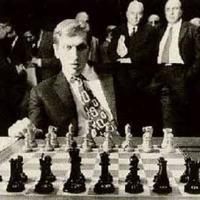
Bobby Fischer
Bobby Fischer’s real name is Robert James Fischer and he was a famous chess player. He represented the United States and Iceland in all of his chess matches. Fischer was born on March 4, 1943 in Chicago, Illinois and he died on January 17, 2008 in Reykjavik, Iceland. He was 64 years old. Bobby Fischer held the title of World Chess Champion in the years 1972-1975. (Fide) His highest achieved ranking was 2785 in July 1972. Robert James Fischer was a chess Grandmaster and was the 11 World Chess Champion. Robert was born as an American citizen but later in his life he renounced his United States citizenship and received full Icelandic citizenship. In the year 1972, he became the first and so far only American in history to win the official world chess championship. In his later years, Fischer lived in Hungary, Germany, the Philippines and Japan.
Bobby Fischer learned to play chess around the age of 6 and as a teenager he was a chess prodigy. Before matches he used to drink orange juice and eat a sandwich. At a very young age Fischer was involved in The Game of the Century. This title refers to a chess game between Donald Byrne and the 13 year old Bobby Fischer in the Rosenwald Memorial Tournament in New York City on October 17, 1956. In this game, Bobby Fischer had played black and Byrne, white. Bobby’s moves in this game demonstrated brilliance, innovation, and poetry. After Byrne made a few standard opening moves, he makes a minor mistake on move 11 by moving the same piece twice. Fischer used that mistake to his advantage and in move 17 he made an incredible Queen sacrifice. Byrne then captured the Queen, but Fischer responded by taking back many other pieces of Byrnes. The ending in this game demonstrated pieces working together to get checkmate…result….Fischer wins.
Fischer’s victories in the U.S. qualified him to participate in the 1958 Portoroz Interzonal, the next step toward challenging the World Champion. The top six finishers in the Portoroz Interzonal would be able to enter the Candidates tournament. In 1960, Fischer tied for first place with the young Soviet Union star Boris Spassky at the Strong Mardel Plata Tournament held in Argentina. A few years later, he declined an invitation to compete in the 1963 Piatigorsky cup tournament in Los Angeles, which had a world class field. Instead, he went to the play in the Western Open in Bay City, Michigan which he won. He also won the 1963 New York State Championship at Poughkeepse another very minor event in which he achieved a perfect score. After a few more wins, he decided to take a break and except for a win at a New York Metropolitan League team match he took the next year and half off. This much needed break readied him for his next match in 1972 which is known as the The Match of the Century.
The Match of the Century was the World Champion Match between challenger Bobby Fischer and defending champion Boris Spassky in Reykjavik, in 1972. This is probably the most known world chess championship match and also the most dramatic. The match was played during the Cold War. For a very long time the Soviet Union chess organization had held a monopoly on chess at a high level and a very highly eccentric young Fischer had been outspoken in his criticism of that Soviet system. He believed that USSR players had gained unfair advantages by making draws among themselves in tournaments. Endowed with a very fierce fighting spirit and a very strong hatred of draws, Fischer had campaigned about this very act. He viewed the Soviets to be liars and most of all hypocrites. The majority of expectations on Spassky winning were very high because for the Soviets chess was a part of the political system part of life.
Fischer, in fact, was no patriot, yet he too carried the burden of expectation because of the political significance of that match. Fischer most of all was very shy of the press. He did not make it to Iceland for the opening ceremony. For a long time it looked doubtful that the match would even be played at all as it was proving impossible for FIDE to accommodate Fischer’s demands. Some of his demands were to ban all the TV cameras and a 30% share of revenue from spectators. He opposed Spassky’s proposals because…well…of course…they were Spassky’s and Bobby would, at times, be difficult when his rivals wishes happened to just coincide wit6h his very own. Bobby’s behavior was very full of self-contradictions. He badly wanted to play this match but would let it go over trivial issues. Finally, after a surprise doubling of the prize money and much persuasion, Fischer agreed to play in the match. Many commentators, mainly from the USSR, have suggested that all this was part of Fischer’s plan to psych out Spassky. Many of Fischer’s supporters say that winning the World Championship was the mission of his life and simply made the setting perfect for his arrival. Bobby ended up winning that match and he became the World Chess Champion.
Bobby Fischer is well known for his openings and some of his most common are: with white pieces are the Sicilian played 173 times, the Ruy Lopez played 115 times, and the Ruy Lopez, closed played 74 times. With black pieces he used the Sicilian a total of 116 times, the Kings Indian played 111 times and the Sicilian Najdorf a total of 77 times. For all his eccentricities, Bobby Fischer was an amazing chess player who won an astounding 415 games, made 248 draws and had only 85 losses out of 748 matches. His play of the game has inspired many others, perhaps even myself, to become the next Grand Master.